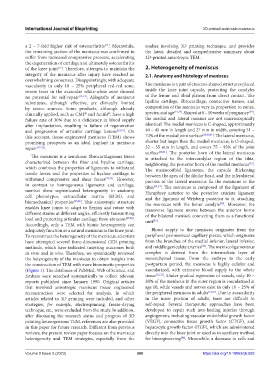Page 368 - IJB-9-3
P. 368
International Journal of Bioprinting 3D-printed anistropic meniscus
a 2 – 7-fold higher risk of osteoarthritis . Meanwhile, studies involving 3D printing technique, and provides
[11]
the remaining section of the meniscus was confirmed to the latest, detailed and comprehensive summary about
suffer from increased compressive pressure, accelerating 3D-printed anisotropic TEM.
the degeneration of cartilage and ultimately osteoarthritis
of the knee joint . Therefore, attempts to maintain the 2. Heterogeneity of meniscus
[12]
integrity of the meniscus after injury have reached an 2.1. Anatomy and histology of meniscus
overwhelming consensus. Disappointingly, with adequate
vascularity in only 10 – 25% peripheral red-red zone, The meniscus is a pair of crescent-shaped structures placed
severe tears in the avascular white-white zone showed inside the knee joint capsule, protecting the condyles
no potential for self-repair [13,14] . Allografts of meniscus of the femur and tibial plateau from direct contact. The
substitutes, although effective, are clinically limited hyaline cartilage, fibrocartilage, connective tissues, and
by scarce sources. Some products, although already composition of the meniscus vary in proportion to zones,
[29]
clinically applied, such as CMI and Actifit , have a high species, and age [14,24] . Shaped at 8 – 10 weeks of pregnancy ,
®
®
failure rate of 30% due to a deficiency in blood supply the medial and lateral menisci are not macroscopically
after implantation, resulting in failure of regeneration identical. The medial meniscus is C-shaped, approximately
and progression of articular cartilage lesions [15,16] . On 40 – 45 mm in length and 27 mm in width, covering 51 –
this account, tissue-engineered meniscus (TEM) shows 74% of the medial joint surface [23,30,31] . The lateral meniscus,
promising prospects as an ideal implant in meniscus shorter but larger than the medial meniscus, is O-shaped,
repair [17-22] . 32 – 35 mm in length, and covers 75 – 93% of the joint
surface [30,31] . The posterior horn of the lateral meniscus
The meniscus is a semilunar fibrocartilaginous tissue is attached to the intercondylar region of the tibia,
characterized between the fiber and hyaline cartilage, neighboring the posterior horn of the medial meniscus .
[32]
which combines the properties of ligaments to withstand The meniscotibial ligaments, the capsule thickening
tensile forces and the properties of hyaline cartilage to between the apex of the fibular head, and the inferolateral
withstand compressive and shear forces [23,24] . However, portion of the lateral meniscus fix the meniscus to the
in contrast to homogeneous ligaments and cartilage, tibia [33,34] . The meniscus is composed of the ligament of
menisci show sophisticated heterogeneity in anatomy, Humphrey anterior to the posterior cruciate ligament
cell phenotypes, extracellular matrix (ECM), and and the ligament of Wrisberg posterior to it, attaching
biomechanical properties [25,26] . This anisotropic structure the meniscus with the femur condyle . Moreover, the
[35]
enables knee joints to adapt to flexion and rotate with transverse ligament moves between the anterior horns
different strains at different angles, efficiently transmitting of the bilateral menisci, connecting them as a functional
load and protecting articular cartilage from abrasion [27,28] . unit .
[35]
Accordingly, only a TEM with bionic heterogeneity can
adequately function as a natural meniscus in the knee joint. Blood supply to the meniscus originates from the
To reconstruct the heterogeneity of the meniscus, scientists peripheral perimeniscal capillary plexus, which originates
have attempted several three-dimensional (3D) printing from the branches of the medial inferior, lateral inferior,
methods, which have indicated inspiring outcomes both and middle geniculate arteries . The meniscoligamentous
[36]
in vitro and in vivo. Therefore, we systemically reviewed complex is derived from the intermediate layer of
the heterogeneity of the meniscus to obtain insights into mesenchymal tissue. From the embryo to the early
the construction of TEM with more biomimetic properties postpartum period, the meniscus is highly cellular and
(Figure 1). The databases of PubMed, Web of Science, and vascularized, with extensive blood supply to the whole
Embase were searched systematically to collect relevant tissue [13,32] . Under gradual regression of vessels, only 10 –
reports published since January 1990. Original articles 30% of the meniscus in the outer region is vascularized at
that involved anisotropic meniscus tissue engineered age 10, while vessels and nerves exist in only 10 – 25% of
reconstruction were selected for analysis, in which the peripheral meniscus in adults [14,37] . Due to avascularity
articles related to 3D printing were included, and other in the inner portion of adults, tears are difficult to
strategies, for example, electrospinning, freeze-drying self-repair. Several therapeutic approaches have been
technique, etc., were excluded from the study. In addition, developed to repair such non-healing injuries through
after discussing the research status and progress of 3D angiogenesis, including vascular endothelial growth factor
printing heterogeneous TEM, references are also provided (VEGF), connective tissue growth factor (CTGF), and
in this paper for future research. Different from previous hepatocyte growth factor (HGF), which are administered
reviews, the present review paper focuses on the meniscus directly into the knee joint or used as in auxiliary method
heterogeneity and TEM strategies, especially from the for bioengineering . Meanwhile, a decrease in cells and
[38]
Volume 9 Issue 3 (2023) 360 https://doi.org/10.18063/ijb.693

